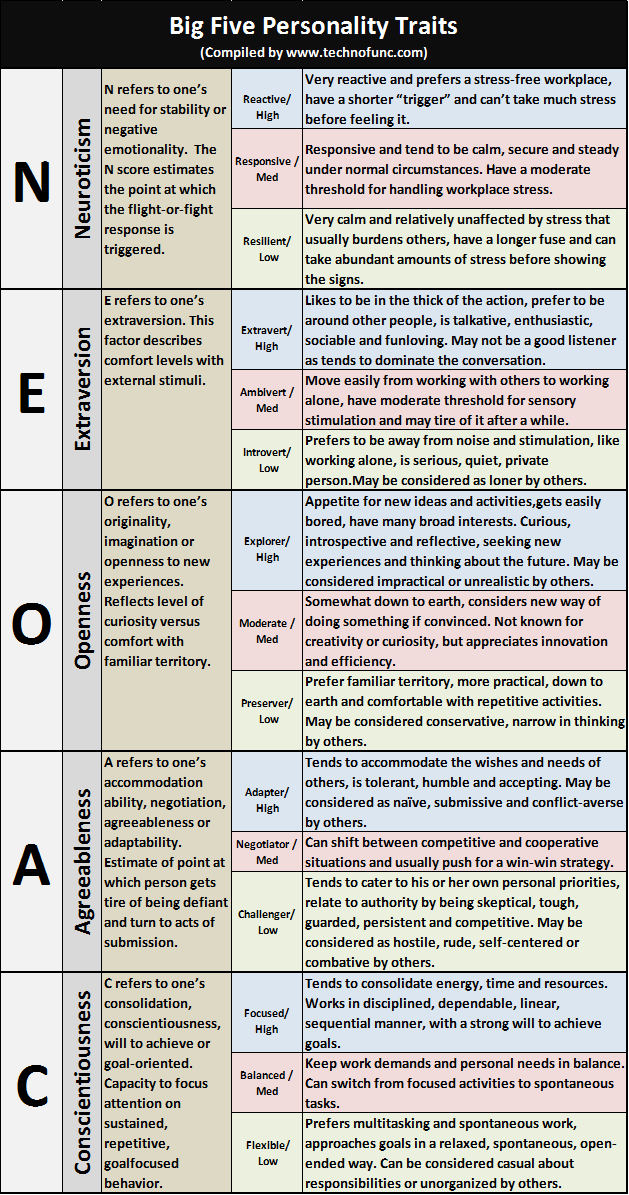- Home
- Business Processes
- Industry Knowledge
- Aerospace Industry
- Automotive Industry
- Banking Domain
- BFSI Industry
- Consumer/ FMCG Industry
- Chemicals Industry
- Engineering & Construction
- Energy Industry
- Education Domain
- Finance Domain
- Hospitality Domain
- Healthcare Industry
- Insurance Domain
- Retail Industry
- Travel and Tourism Domain
- Telecom Industry
- Leadership Skills
- eLearning
- Home
- Leadership
- Leadership Theories
- Five-Factor Personality Model
Five-Factor Personality Model
Five Factors Model (FFM) also known as Five-Factor Personality Model is based on five broad personality traits which are extraversion, neuroticism, openness to experience, agreeableness, and conscientiousness represented by acronym OCEAN, these traits are often referred to as the “Big Five”.
What are Big Five Personality Traits:
Over the past 25 years, a consensus has emerged among researchers regarding the basic factors that make up what we call personality. Psychologists now believe that of all the various methods for classifying personality dimensions, only one stands out as the most statistically robust: the Big Five. These factors, commonly called the Big Five, are neuroticism, extraversion, openness, agreeableness and conscientiousness.
N = Neuroticism = Need for stability, negative emotionality
E = Extraversion = Positive emotionality, sociability
O = Openness = Originality, imagination
A = Agreeableness = Accommodation, adaptability
C = Conscientiousness = Consolidation, will to achieve, goal-oriented
Table below provides the description, attributes and explanations for each of the factors listed above. These five personality factors are the most reliable for differentiating personality traits. The Big Five synonym clusters appear to account for most differences among individual personalities, describing five universal dimensions. We score a high, low or mid-range rating in each dimension and interpretations of the scores is given below:
|
Big Five Personality Traits |
||||
|
N |
Neuroticism |
N refers to one’s need for stability or negative emotionality. The N score estimates the point at which the flight-or-fight response is triggered. |
|
Very reactive and prefers a stress-free workplace, have a shorter “trigger” and can’t take much stress before feeling it. |
|
Responsive / |
Responsive and tend to be calm, secure and steady under normal circumstances. Have a moderate threshold for handling workplace stress. |
|||
|
Resilient/ |
Very calm and relatively unaffected by stress that usually burdens others, have a longer fuse and can take abundant amounts of stress before showing the signs. |
|||
|
E |
Extraversion |
E refers to one’s extraversion. This factor describes comfort levels with external stimuli. |
|
Likes to be in the thick of the action, prefer to be around other people, is talkative, enthusiastic, sociable and funloving. May not be a good listener as tends to dominate the conversation. |
|
Ambivert / |
Move easily from working with others to working alone, have moderate threshold for sensory stimulation and may tire of it after a while. |
|||
|
Introvert/ |
Prefers to be away from noise and stimulation, like working alone, is serious, quiet, private person.May be considered as loner by others. |
|||
|
O |
Openness |
O refers to one’s originality, imagination or openness to new experiences. Reflects level of curiosity versus comfort with familiar territory. |
|
Appetite for new ideas and activities,gets easily bored, have many broad interests. Curious, introspective and reflective, seeking new experiences and thinking about the future. May be considered impractical or unrealistic by others. |
|
Moderate / |
Somewhat down to earth, considers new way of doing something if convinced. Not known for creativity or curiosity, but appreciates innovation and efficiency. |
|||
|
Preserver/ |
Prefer familiar territory, more practical, down to earth and comfortable with repetitive activities. May be considered conservative, narrow in thinking by others. |
|||
|
A |
Agreeableness |
A refers to one’s accommodation ability, negotiation, agreeableness or adaptability. Estimate of point at which person gets tire of being defiant and turn to acts of submission. |
|
Tends to accommodate the wishes and needs of others, is tolerant, humble and accepting. May be considered as naïve, submissive and conflict-averse by others. |
|
Negotiator / |
Can shift between competitive and cooperative situations and usually push for a win-win strategy. |
|||
|
Challenger/ |
Tends to cater to his or her own personal priorities, relate to authority by being skeptical, tough, guarded, persistent and competitive. May be considered as hostile, rude, self-centered or combative by others. |
|||
|
C |
Conscientiousness |
C refers to one’s consolidation, conscientiousness, will to achieve or goal-oriented. Capacity to focus attention on sustained, repetitive, goalfocused behavior. |
|
Tends to consolidate energy, time and resources. Works in disciplined, dependable, linear, sequential manner, with a strong will to achieve goals. |
|
Balanced / |
Keep work demands and personal needs in balance. Can switch from focused activities to spontaneous tasks. |
|||
|
Flexible/ |
Prefers multitasking and spontaneous work, approaches goals in a relaxed, spontaneous, open-ended way. Can be considered casual about responsibilities or unorganized by others. |
|||
Study to Examine Big Five Personality Dimensions:
To assess the links between the Big Five and leadership, Judge, Bono, Ilies, and Gerhardt (2002) conducted a major meta-analysis of 78 leadership and personality studies and found a strong relationship between the Big Five traits and leadership.
This model of leadership was result of a study to examine the relationship between the “Big Five” personality dimensions (neuroticism, conscientiousness, extraversion, agreeableness, and openness) with respect to career success. A sample of few hundred employees was surveyed in a diverse set of occupations and organizations. Hierarchical regression analysis was used to examine the incremental variance contributed by the five personality traits after controlling for several career-related variables.
Results showed that, extraversion was related positively to salary level, promotions, and career satisfaction and that neuroticism was related negatively to career satisfaction. Agreeableness was related negatively only to career satisfaction and openness was related negatively to salary level. It was confirmed as expected that having certain personality traits is associated with being an effective leader.
Is the Big Five personality assessment valid?
Researchers have pointed to reliability studies that are consistent enough to approach the status of law and for the corporate world; this model provides a reliable, standard vocabulary with which to discuss personality differences. Although the Big Five model gives us a uniform language based on standard definitions, but the fact remains that a combination of forces shape an individual. The Five Factors can be thought as being the main infrastructure as human individuality is too complex for any one system to explain adequately.
This personality assessment can be practically applied to identify the needs of a specific role prior to selecting or appointing a leader and performing a match of factors to determine success of the individual in the role.

Related Links
You May Also Like
-
Lewin’s Change Management Model
Lewin's change management model is a framework for managing organizational change. Lewin's methodology of different Leadership Styles recognizes three distinct stages of change - creating the perception; moving toward the new desired level of behavior and, ensuring new behavior as the norm.
-
The Systemic Approach to Leadership
The systemic approach to leadership looks at the organization as a whole and focuses on the understanding of the organization as a system. Moving to systems thinking demand managers to view organizations as organic systems. Leaders are also part of this complex system which is constantly undergoing change and evolving. The leaders need to manage the relations and networks within these systems by acting with systemic awareness.
-
Rensis Likert studied the patterns and styles of managers and developed four management systems known as Likert's management systems. These styles developed by him are known as Likert management systems. System 1 - Exploitative Authoritative; System 2 - Benevolent Authoritative; System 3 - Consultative and System 4 - Participative.
-
Reciprocal influence theory also known as reciprocal determinism is authored by Albert Bandura and states that an individual's behavior influences and is influenced by both the social world and personal characteristics. Three factors that influence behavior are the environment, the individual, and the behavior itself. Certain leader behaviors can cause subordinate behaviors and reciprocal influence on the leader by the group.
-
Attribution Theory of Leadership
The attribution theory of leadership deals with the formation of individual opinions about the reasons for particular events or observations. People will always try to understand why people do what they do. The leader will make a judgment about his employees based on his attribution of the causes of the employees' performance. Individuals will also make inferences about the leader and react to poor performance by the leader.
-
Leadership Participation Inventory (LPI)
Kouzes and Posner introduced the Leadership Participation Inventory model of Transformational leadership. This model is also known as Kouzes and Posner's Leadership Challenge Model. They identified five practices of exemplary leadership - Model the Way, Inspire a Shared Vision, Challenge the Process, Enabling Others to Act, and Encourage the Heart.
-
The Path-Goal theory defines the characteristics of followers and organizational context and the corresponding leadership style best suited to these factors. A leader should adapt to a behavior that is most relevant for a given employee and work environment mix to achieve a goal. The application of theory drives increased employees' motivation, empowerment, and satisfaction resulting in increased productivity.
-
According to the three-skill approach of Katz, the individual's leadership abilities vary depending on where leaders are in a management hierarchy. The practical implication of skills approach to leadership is that leaders can improve their capabilities in leadership skills through training and experience.
-
Power is the ability to exercise influence or control over others. Leadership involves authority and it is very important for leaders to understand what type of power they're using. The 5 Types of Power in Leadership are Coercive power, expert power, legitimate power, referent power, and reward power. Authority is the right to command and extract obedience from others. It comes from the organization and it allows the leader to use power.
-
According to Environmental theories of leadership, a leader needs to deal effectively with environmental complexities and lead in a certain style as a result of environmental responses. Environmental influenced leadership demand leaders to learn how to adjust environmental factors. Leaders also have the responsibility of creating the right kind of environment for their followers by focusing on environmental factors and pressures.
Explore Our Free Training Articles or
Sign Up to Start With Our eLearning Courses

About Us
Learning
© 2023 TechnoFunc, All Rights Reserved









